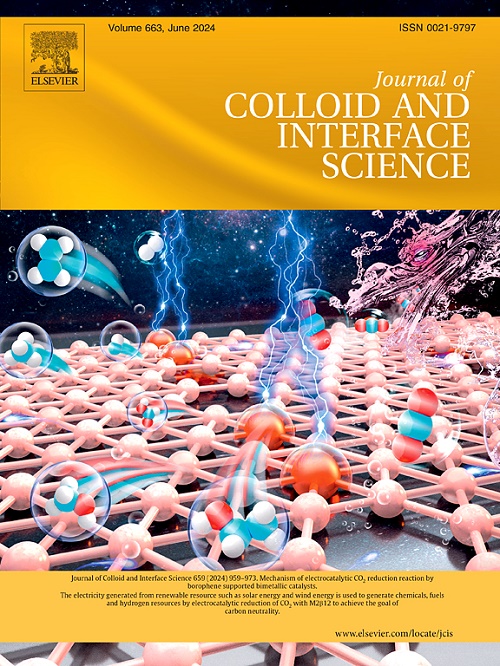Ru/Co-S键合单原子和纳米粒子催化剂在可充电锌空气电池中的高性能双功能氧电催化
IF 9.7
1区 化学
Q1 CHEMISTRY, PHYSICAL
引用次数: 0
摘要
开发高效、可持续的能源转换与储存技术是现代科学技术研究的重点。本研究将Ru单原子掺杂到锌分子筛咪唑骨架(Ru- zif -8)中,在界面处吸附Co纳米粒子进行第一次热解,引入S进行第二次热解,得到Ru单原子与Co纳米粒子组成的复合双功能电催化剂(Co@Ru-SAs-HSNC), Ru/Co-S配位,稳定锚定在空心n掺杂碳基体上。理论计算结果表明,引入S原子取代N原子形成Ru位点为反应提供了更大的驱动力,调节了电子结构,减缓了金属颗粒烧结的失活。二次热解可以使催化剂产生更多的活性位点,形成更加均匀稳定的孔隙结构,提高催化剂的活性和稳定性。在碱性环境下,Co@Ru-SAs-HSNC在氧还原反应(ORR)中表现出0.90 V的高半波电位,在50 mA cm−2的析氧反应(OER)中表现出278 mV的低过电位。此外,Co@Ru-SAs-HSNC作为可充电锌-空气电池的正极,实现了205 mW cm - 2的峰值功率密度。从长期恒流充放电试验中可以看出,Co@Ru-SAs-HSNC的循环时间可达1134 h,往返效率高。本文章由计算机程序翻译,如有差异,请以英文原文为准。

Synergistic Ru/Co-S bonded single-atom and nanoparticle catalysts for high-performance bifunctional oxygen electrocatalysis in rechargeable zinc-air batteries
The development of efficient and sustainable energy conversion and storage technologies is the focus of modern scientific and technological research. This study doped Ru single atoms into a zinc zeolite imidazole framework (Ru-ZIF-8), followed by the adsorption of Co nanoparticles at the interface for the first pyrolysis and the introduction of S for the second pyrolysis to obtain a composite bifunctional electrocatalyst composed of Ru single atoms and Co nanoparticles (Co@Ru-SAs-HSNC), with Ru/Co-S coordination and stable anchoring on a hollow N-doped carbon substrate. The theoretical calculation results revealed that the introduction of S atoms to replace N atoms and form Ru sites provided a greater driving force for the reaction, regulated the electronic structure, and slowed the deactivation of the sintering of the metal particles. The secondary pyrolysis could produce more active sites for the catalyst and form a more uniform and stable pore structure, improving the activity and stability of the catalyst. In an alkaline environment, Co@Ru-SAs-HSNC exhibited a high half-wave potential of 0.90 V in the oxygen reduction reaction (ORR) and a low overpotential of 278 mV at 50 mA cm−2 in the oxygen evolution reaction (OER). Additionally, Co@Ru-SAs-HSNC was used as the positive electrode of a rechargeable zinc-air battery, achieving a 205 mW cm−2 peak power density. As shown in the long-term constant-current charge–discharge tests, Co@Ru-SAs-HSNC had a cycle time of up to 1134 h with high round-trip efficiency.
求助全文
通过发布文献求助,成功后即可免费获取论文全文。
去求助
来源期刊
CiteScore
16.10
自引率
7.10%
发文量
2568
审稿时长
2 months
期刊介绍:
The Journal of Colloid and Interface Science publishes original research findings on the fundamental principles of colloid and interface science, as well as innovative applications in various fields. The criteria for publication include impact, quality, novelty, and originality.
Emphasis:
The journal emphasizes fundamental scientific innovation within the following categories:
A.Colloidal Materials and Nanomaterials
B.Soft Colloidal and Self-Assembly Systems
C.Adsorption, Catalysis, and Electrochemistry
D.Interfacial Processes, Capillarity, and Wetting
E.Biomaterials and Nanomedicine
F.Energy Conversion and Storage, and Environmental Technologies

 求助内容:
求助内容: 应助结果提醒方式:
应助结果提醒方式:


